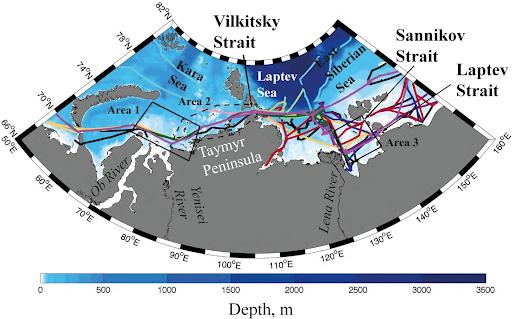
Credit: Alexander Osadchiev et al./Scientific Reports
The Ob, Yenisei, and Lena rivers flow into the Kara and Laptev seas and account for about half of the total freshwater runoff to the Arctic Ocean. The transport and transformation of freshwater discharge in these seas have a large impact on ice formation, biological productivity, and many other processes in the Arctic. Researchers from Shirshov Institute of Oceanology and MIPT have investigated the spreading of large river plumes — that is, freshened water masses formed as a result of river runoff mixing with ambient saltwater — in the Russian Arctic seas. The findings were published in Scientific Reports.
The Ob, Yenisei, and Lena rivers provide a huge volume of freshwater discharge to the Kara and Laptev seas. The total annual runoff from these three rivers is estimated at 2,300 cubic kilometers. The majority of this volume is discharged into the sea during the ice-free season, forming the Ob-Yenisei plume and the Lena plume, which are the largest in the Arctic and among the largest in the world ocean.
“River plumes are freshened water masses that form near river mouths and spread at sea as a relatively thin surface layer. River plume dynamics are mostly determined by wind forcing and river discharge rate,” explained Alexander Osadchiev, a co-author of the study and a senior researcher at Shirshov Institute of Oceanology.
Previous studies revealed that in the absence of strong wind, the Coriolis force and the density gradient between the plume and the ambient seawater cause alongshore spreading of river plumes. That process induces a large-scale eastward freshwater transport that is observed in the Arctic Ocean along large segments of the Eurasian and North American shores. This feature strongly affects ice conditions in the region.
The study described in this article revealed how the Ob-Yenisei plume spreads from the Kara Sea to the Laptev Sea through the Vilkitsky Strait, which is located between the Severnaya Zemlya archipelago and the Taymyr Peninsula. The paper also addresses the Lena plume and its spreading from the Laptev Sea into the East Siberian Sea through the Laptev and Sannikov straits.
The authors demonstrated that continental runoff from the Ob and Yenisei mostly accumulates in the Kara Sea during the ice-free season. Topographic barriers — namely, the western coast of the Taymyr Peninsula and the Severnaya Zemlya archipelago — generally hinder eastward spreading of the Ob-Yenisei plume to the Laptev Sea. This process occurs only as a result of very specific wind forcing conditions.
On the contrary, the Lena plume is almost constantly spreading to the western part of the East Siberean Sea as a large-scale water mass, forming a narrow freshened coastal current in the eastern part of this sea. Known as the Siberian Coastal Current, it is intensified by freshwater runoff from the large Indigirka and Kolyma rivers and flows farther eastward to the Chukchi Sea.
“Freshwater from the rivers flowing into the Arctic Ocean very slowly mixes with seawater, therefore the large river plumes are very stable. As we revealed, freshwater can spread eastward across hundreds of kilometers, forced by local winds. The recent findings enable us to assess freshwater transport between the Kara, Laptev, and East Siberian seas during the ice-free season,” added Associate Professor Sergey Shchuka, deputy chair of ocean thermohydromechanics at MIPT.
The new data are crucial for understanding ice formation, biological productivity, and many other processes in the Arctic affected by continental runoff.
###
The study also featured researchers from Tomsk Polytechnic University and Ilyichov Pacific Oceanological Institute. This research was supported by the Russian Ministry for Higher Education and Science, the Russian Government, the Russian Foundation for Basic Research, the Russian Science Foundation, the Russian Presidential Grant, and Tomsk Polytechnic University.
Media Contact
Varvara Bogomolova
[email protected]
Original Source
https:/
Related Journal Article
http://dx.




